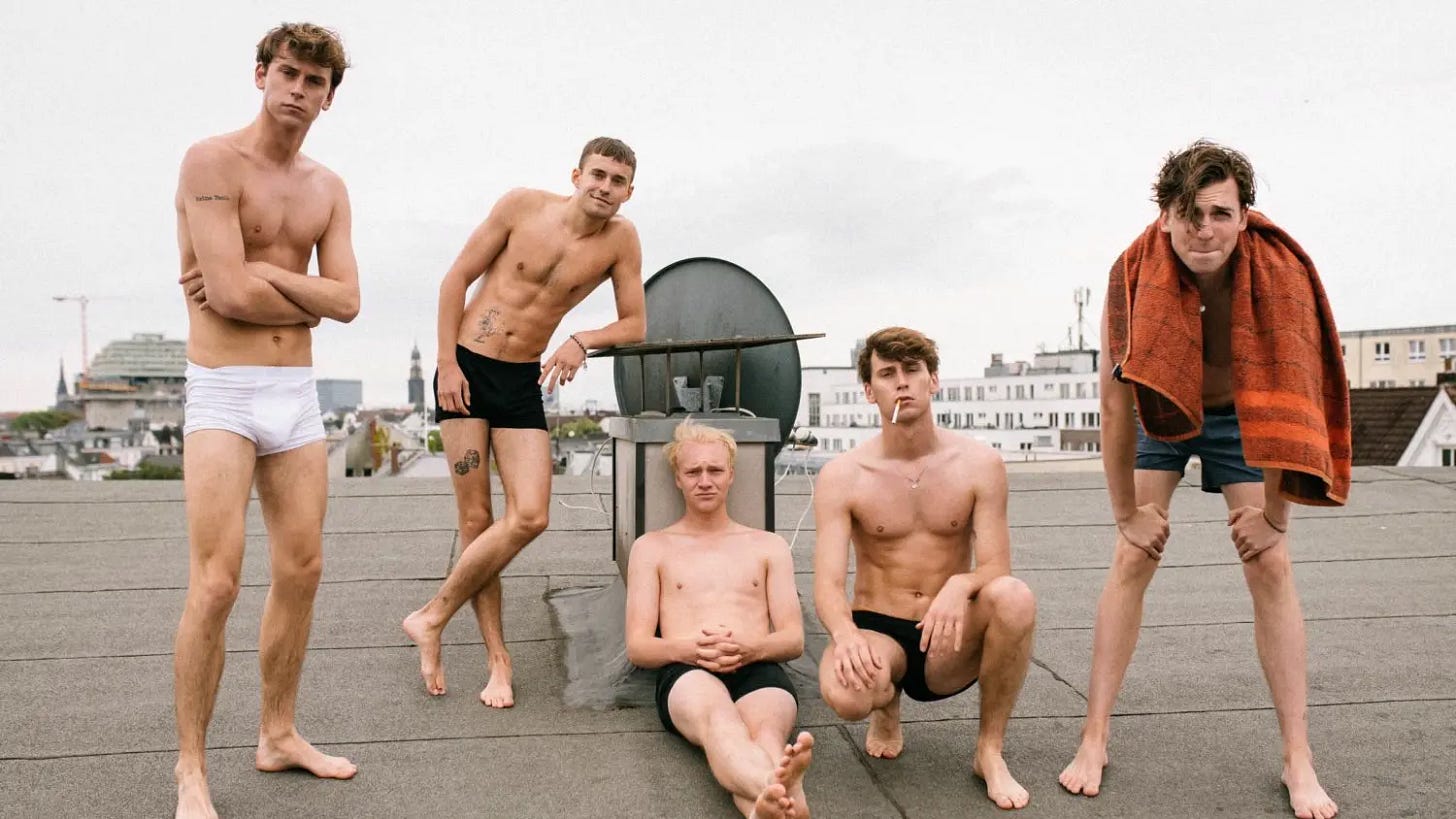Einer der beliebtesten Posts in meiner LinkedIn-Bubble ist der „Wir brauchen mehr unorthodoxe Denker“-Post. Es gibt ihn in unterschiedlichen Varianten, aber er funktioniert immer gleich: User postet ein Video mit süßen Hundewelpen, Affen oder Kindern, die versuchen, an schwer zu erreichende Nahrung zu gelangen. Eines ums andere scheitert, bis schließlich der Maverick kommt, der nicht denselben Weg wählt wie die anderen und sich das Naschwerk einverleibt.
Die Absender dieser Posts denken natürlich, dass sie die kongenialen Outside-the-Box-Querdenker sind, deren Nonkonformismus Steve Jobs vor Neid erblassen ließe, würde Steve Jobs noch vor Neid erblassen. Wie gern wäre ich auch so ein cleveres Hündchen, das seine Schnauze in Ambrosia badet und seinen Hintern verschämt in einem Recaro-Sitz und nicht in einem chinesischen Drehstuhl windet. Gelindert wird der Schmerz, der mit der Erkenntnis der eigenen Unzulänglichkeit einhergeht, nur von dem beruhigenden Wissen, dass die intellektuelle Elite der westlichen Welt nicht mehr in Reih und Glied marschiert, sondern aufsteht gegen die Gleichschaltung des Denkens. Eine Armee der Individualisten. Jeder schlägt sich mit Machetenverstand seinen eigenen Weg abseits der Autobahn tradierter Lösungsansätze.
Am nächsten Tag posten sie dann ein von ChatGPT erstelltes und eingeblistertes Abbild ihrer selbst als Actionfigur. Alle. An ihrer Seite verschweißt: ihre drei total individuellen Supertools: weiße Sneakers, Laptop und eine Flasche Weißwein. Meine am Vortrag frisch aufgekeimte Hoffnung legt sich wortlos neben Steve Jobs. Über mich legt sich eine seltsame Ruhe.
Gedankenverloren verscheuche ich eine Fliege, die meine Autry Medalist Low umkreist, schenke mir ein Glas Grauburgunder ein, öffne das MacBook und mache mich daran, das Intro für den Media X Culture Brief #11 zu schreiben.
Ein Instrument erlernt man, indem man covert. Das ist völlig legitim und zielführend. Tausende Mädchen und Jungs auf der Welt mühen sich derzeit damit ab, den Titel-Track von „Fluch der Karibik“ auf dem Klavier zu meistern. So sie dieses Tal der Misserfolge, Tränen und Wutanfälle überwinden und weitermachen, werden einige von ihnen durch die erfolgreiche Imitation etwas darüber gelernt haben, wie das Instrument und vielleicht sogar, wie Songwriting funktioniert. Ganz wenige von ihnen werden beginnen, ein tiefgreifendes Verständnis dafür zu entwickeln, wie Musik funktioniert. Nicht nur in ihrem Kopf, sondern in ihrem Bauch und ihrem Herzen. Diese wenigen werden aufhören zu imitieren und anfangen zu kreieren.
Da Klaviere extrem sperrig und teuer sind, bekommen alle Kinder zum nächsten Weihnachtsfest Synthesizer geschenkt. Mit 1500 verschiedenen Instrumenten und weirden Sounds, automatischer Bassbegleitung, Vorschlägen für Fingersätze und Akkordfolgen. Für diejenigen, die ein tiefgreifendes Verständnis (oder Gefühl) für Musik entwickelt haben, eröffnet das Geschenk ungeahnte kreative Möglichkeiten. Für die Imitatoren bietet es die Chance, ohne Anstrengung wohlwollenden Applaus bei Familienfeiern einzufahren.
Künstliche Intelligenz ist ein Synthesizer auf Steroiden.
Sie ermöglicht kreativ nicht sonderlich begabten Menschen, mit minimalem Einsatz erstaunliche Ergebnisse zu erzielen und wird so innerhalb kürzester Zeit Trends setzen und verstärken. Der Produktionsaufwand für handwerklich soliden Output sinkt. Das heißt jedoch nicht, dass wir in der Breite mehr „echte“ Kreativität sehen werden.
Für diejenigen, die in der Lage sind, Neues zu erdenken und zu beschreiben, kann Künstliche Intelligenz eine Superkraft sein, mit der sie in neue Sphären vorstoßen – wenn sie sie einzusetzen wissen und sich nicht im Kaninchenbau der generischen Belanglosigkeiten verlieren.
Kunst kann ihre Kraft nur entfalten, wenn sie Aufmerksamkeit bekommt, da sie erst im Auge oder Ohr des Betrachters entsteht. Gleiches gilt für Kommunikation. Natürlich wird KI ihren Platz in Kreation und Media einnehmen. Um wahrgenommen und erinnert zu werden, braucht’s jedoch nicht die Learnings und den größten gemeinsamen Nenner aus 200.000 vorangegangenen Kampagnen, sondern nach wie vor die eine originäre Idee. Und die ist oft ganz weit weg vom Mainstream – wie zum Beispiel die deutsche Impro-Serie „Intimate“ oder das Comeback des Cow-Prints.
Wirklich Neues entsteht nicht durch Nachahmung, sondern durch das Mutige, das Unvorhersehbare und das unverwechselbar Eigene. Viel Spaß bei der Lektüre!
“Average is nothing to aspire to. The goal is not to fit in.”
Rick Rubin
International News
🧾 DMA strikes: EU fines Apple €500M, Meta €200M
The European Commission has handed out the first-ever fines under the Digital Markets Act (DMA):
Apple: Fined €500 million for blocking app developers from steering users to cheaper offers outside the App Store. The EU says Apple’s restrictions prevent fair competition and harm consumer choice.
Meta: Fined €200 million for its controversial “consent or pay” model on Facebook and Instagram. Between March and November 2024, users had to either accept data tracking or pay – without a true privacy-friendly alternative.
📌 Why it matters:
Europe is forcing Big Tech to play fair. Expect less data, more compliance checks, and pressure on platforms to change monetisation models – with ripple effects for targeting, campaign planning, and app-based media.
🧠 HBR: How to advertise to distracted consumers
New research published in Harvard Business Review reveals that distracted consumers are still persuadable — just differently. In a large-scale study, ads served during moments of distraction (e.g., multitasking, passive scrolling) were less effective at creating recall, but they still drove action, particularly impulse behaviors like click-throughs and add-to-cart conversions.
Key findings:
High-attention consumers respond better to narrative, emotional, or informative messaging.
Distracted consumers engage more with simple, visually salient ads — think bold headlines, static images, or short videos with strong CTAs.
Media context matters: lean-back environments (like CTV or passive mobile scroll) are prime spots for “low-cognitive” ad formats.
📌 Why it matters:
As multitasking becomes the norm, understanding when and how to match creative format to consumer attention state is crucial. This research backs the trend toward attention planning and creative adaptation in media strategy.
📈 Meta opens Threads to advertisers worldwide
Meta has officially expanded advertising on Threads to all eligible advertisers globally. This move follows a limited test phase that began in January 2025 with select brands in the U.S. and Japan.
Ads on Threads will appear in users' feeds with a gray “Sponsored” label next to the account username. Advertisers can access this placement through Meta’s Advantage+ or Manual Placements options, with the ability to opt out if desired. Meta emphasizes its brand safety standards, ensuring that ads do not appear near content violating community guidelines.
📌 Why it matters:
For media strategists and buyers, Threads offers a new avenue to reach audiences.
🤖 AI Acceleration in APAC: Japan and Korea ramp up retail innovation
Japan is experiencing a significant surge in AI integration within the retail sector. The market for AI in retail is projected to grow from USD 460.71 million in 2023 to USD 5.48 billion by 2032, reflecting a CAGR of 31.66%. This growth is driven by the adoption of technologies such as machine learning, natural language processing, and computer vision to enhance customer experiences, optimize supply chains, and personalize marketing strategies.
South Korea is also making strides in AI adoption across the retail industry. The government aims to increase AI utilization in retail from below 3% to 30% within three years. Initiatives focus on enhancing commercialization, marketing, store operations, logistics, and customer experience through AI technologies.
📌 Why it matters:
For media strategists and buyers, these developments signal a shift towards data-driven personalization, automated customer interactions, and optimized supply chains.
🍪 Google delays cookie deprecation (again)
Google has announced yet another delay in phasing out third-party cookies from Chrome, pushing the timeline well into 2025. The reason? Ongoing regulatory scrutiny from the UK’s Competition and Markets Authority (CMA) and a lack of clarity around the effectiveness of Google’s proposed Privacy Sandbox tools.
The CMA wants more time to evaluate whether Google's cookieless replacements genuinely preserve competition and user privacy — and Google says it won’t make any moves without regulatory approval.
📌 Why it matters:
This isn’t just a tech issue — it’s a media planning puzzle. The delay gives marketers more time to adapt, but also prolongs uncertainty. Brands and agencies should keep testing first-party data strategies while pressure-testing Privacy Sandbox alternatives like Topics and Protected Audiences.
Local News (Europe)
🇫🇷 French media coalition sues Meta over ad dominance
A coalition of 67 French media companies, including TF1, France Télévisions, and Le Figaro, has filed a lawsuit against Meta in the Paris business tribunal. The plaintiffs allege that Meta's dominant position in digital advertising is maintained through unlawful practices, such as extensive personal data collection and targeted advertising techniques. This legal action follows a broader pattern of increasing scrutiny of Meta’s operations in Europe.
📌 Why it matters: This lawsuit could set a precedent for how digital advertising practices are regulated in Europe, potentially impacting data collection and targeting methods.
🇩🇪🇫🇷 Bertelsmann seeks to revive €3.6bn French TV merger
Bertelsmann CEO Thomas Rabe is attempting to resurrect a previously abandoned €3.6 billion merger between French broadcasters M6 and TF1. The deal, initially scrapped in 2022 due to regulatory concerns, aims to create a stronger competitor against international streaming platforms. Recent shifts in EU regulatory attitudes suggest a possible relaxation of merger scrutiny to promote European industrial champions. Financial Times
📌 Why it matters: If successful, the merger could reshape the French media landscape and influence future consolidation efforts in the European broadcasting sector.
🇬🇧 WPP's Q1 2025 revenue declines amid global economic uncertainty
WPP, one of the world's largest advertising companies, reported a 5% year-over-year decline in revenue for Q1 2025, amounting to £3.24 billion. On a like-for-like basis, revenue fell by 0.7%, while revenue less pass-through costs decreased by 2.7%. The UK market experienced a 5.5% decline, attributed to reduced project-based spending in sectors like automotive and healthcare. CEO Mark Read noted that while WPP is not directly affected by tariffs, the broader economic environment and client operations are impacted. Despite these challenges, WPP maintains its full-year guidance, expecting like-for-like revenue to be flat or decline by up to 2%, with performance anticipated to improve in the second half of the year.
📌 Why it matters: WPP's performance serves as a bellwether for the advertising industry, reflecting broader economic trends and client spending behaviors.
Culture Club
🎵 Video: Chloe Qisha - “Modern Romance”
Chloe Qisha is a Malaysian-born, London-based singer-songwriter and self-taught multi-instrumentalist making waves in the alternative pop scene. Her music blends nostalgic '80s influences with contemporary pop sensibilities, drawing comparisons to artists like Troye Sivan and Chappell Roan.
After releasing her debut EP in November 2024, which garnered critical acclaim and BBC Radio 1's "Track of the Week," Chloe quickly gained momentum. Her single "21st Century Cool Girl" propelled her to over 1 million monthly listeners on Spotify by February 2025. ”Modern Romance” is here latest track.
Chloe's lyrics often explore themes of modern romance and existential dread, resonating with a generation navigating love and identity in the digital age.
With performances at notable festivals like Pitchfork Paris and The Great Escape, Chloe Qisha is solidifying her place as a compelling voice in contemporary pop music.
🎬 “Intimate” – A New Blueprint for Storytelling in 2025
The German comedy series Intimate., now in its second season on Joyn and ProSieben, brings raw humor and chaotic millennial energy straight out of Hamburg.
Created by and starring Bruno Alexander, Emil Belton, Oskar Belton, Max Mattis, and Leonard Fuchs, the show evolved from their original YouTube series (2017–2020) — and still carries that DIY spirit.
Shot in an improvised, semi-autobiographical style, Intimate. follows five friends stumbling through the mess of adult life: cohabitation, creative burnout, friendship crises, and the everyday absurdity of trying to “make it” in your twenties.
It’s loose, intimate, awkward — and somehow both deeply funny and existentially sharp.
🐮 Cow Print Bags – The Bold Accessory of Summer 2025
Move over, classic black handbags—cow print bags are taking center stage in Europe's fashion scene this summer. Once a nostalgic nod to '90s style, cow print has re-emerged with a contemporary twist, becoming a favorite among fashion-forward individuals seeking to make a statement.
Luxury brands like Dior, Bottega Veneta, and Talia Byre have embraced the trend, featuring cow print accessories in their recent collections. High-street labels such as Mango and Samsøe Samsøe are also offering accessible options, making the trend widely available. The resurgence is partly attributed to Prada's iconic 1991 collection, which has inspired a new generation of designers and fashion enthusiasts.
🧠 Contextual Comeback
In den letzten Jahren galt kontextuelles Targeting vielen als altmodisch – überholt von Lookalike-Modellen, Audience-Data und Behavioural Targeting. Doch seit der Cookie-Crunch Realität wird und Regulierung den Zugriff auf persönliche Daten erschwert, erlebt der Ansatz ein Comeback. Und dieses Mal ist er smarter, präziser und programmatisch anschlussfähig.
Kontextuelles Targeting 2025 basiert auf:
semantischer Analyse kompletter Seiteninhalte (nicht nur Keywords)
Natural Language Processing (NLP), um Tonalität, Relevanz und Stimmung zu verstehen
visueller Kontextanalyse: Erkennung von Bildinhalten via KI
Markensicherheitslayern, die toxische oder irrelevante Umfelder ausschließen
Tools wie GumGum, Seedtag, Zefr oder IAS setzen diese Technologien bereits in Video-, Display- und CTV-Kampagnen ein. In Deutschland gilt es Cronbach im Auge zu behalten.
Warum kommt das Thema jetzt zurück?
Ende der Third-Party-Cookies (vielleicht wirklich)
Google hat zwar das Ende erneut verschoben, doch viele Advertiser wollen sich nicht länger abhängig machen.
📌 Insight: Bereits 38 % der EU-Kampagnen setzen 2025 mindestens teilweise auf kontextuelle Lösungen. (Quelle: IAB Europe Report, März 2025)Datenschutzdruck durch DMA und DSGVO
Verarbeitung personenbezogener Daten ohne aktive Zustimmung ist in vielen europäischen Märkten de facto ausgeschlossen. Kontextuelles Targeting bleibt davon weitgehend unberührt.Technologischer Fortschritt
KI-gestützte Analysen ermöglichen heute Kontextverständnis auf Niveau menschlicher Redaktion – in Echtzeit und skalierbar.
Was bedeutet das für Media-Strateg:innen?
Kontext ersetzt keine Zielgruppe, aber er definiert den Moment der Relevanz. Ein paar strategische Lehren:
Setze semantisches Targeting für Upper-Funnel-Ziele ein: Branding, Awareness, thematische Nähe.
Nutze kontextuelle Insights, um kreative Varianten zu differenzieren – etwa nach Stimmung (“informativ” vs. “unterhaltsam”).
Kombiniere Kontext mit Attention Metrics für maximale Wirkung.
Fazit
Kontextuelles Targeting ist zurück – aber nicht als Plan B, sondern als strategisch relevante, datenschutzkonforme Alternative. Wer jetzt in Technologien, Tests und kreative Differenzierung investiert, sichert sich einen Vorsprung in der Post-Cookie-Ära.
That’s it. Thanks for reading the media x culture brief #11/ 2025. If you appreciated the experience feel free to share this post with colleagues, friends and enemies.








